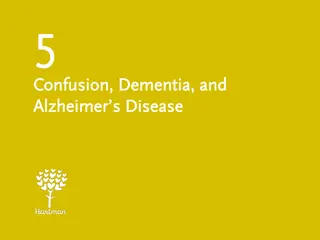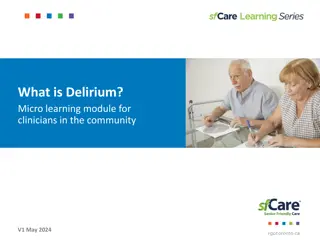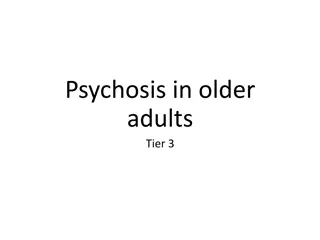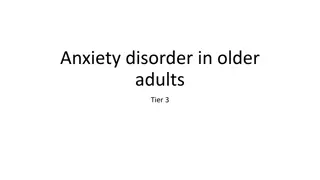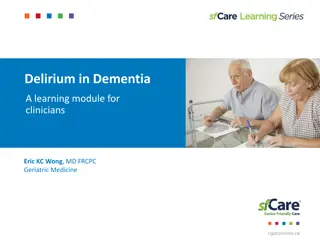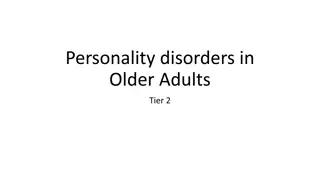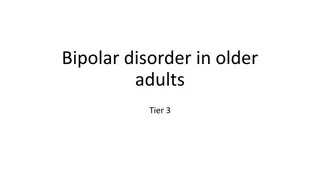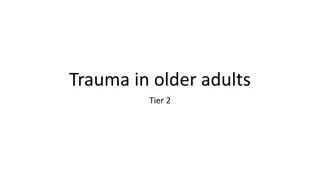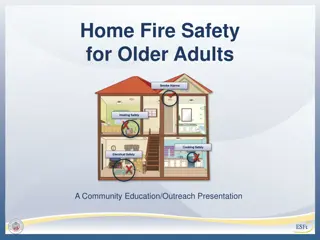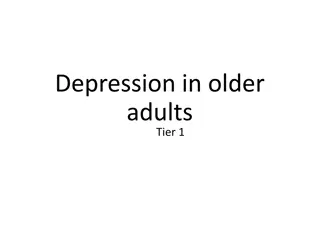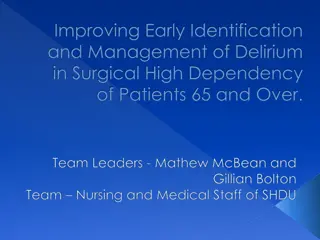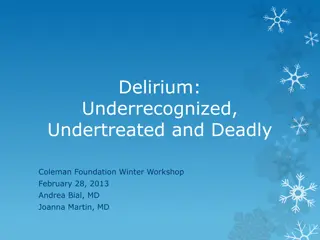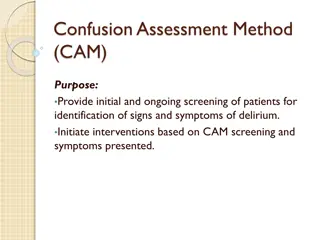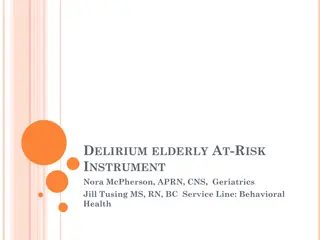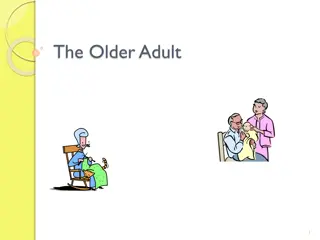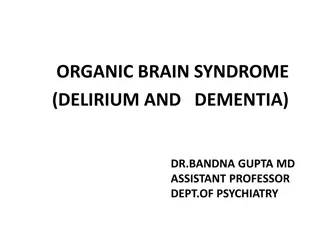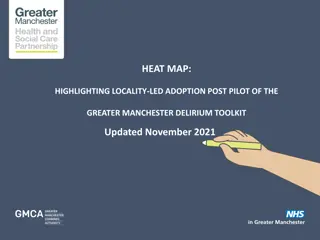Understanding Delirium in Older Adults: Types, Causes, and Symptoms
Delirium in older adults is a complex syndrome characterized by disturbances in consciousness, attention, perception, thinking, memory, and behavior. It commonly presents as hyperactive, hypoactive, or mixed types and can be caused by various factors such as medication, infections, metabolic imbalances, and environmental issues. Recognizing the symptoms, including acute onset, fluctuating course, inattention, disrupted sleep pattern, and altered cognition, is crucial for timely intervention. Predisposing factors like advanced age, cognitive impairment, and underlying illnesses increase the risk of developing delirium. Early identification and management are essential to prevent complications and promote recovery in older adults.
Download Presentation

Please find below an Image/Link to download the presentation.
The content on the website is provided AS IS for your information and personal use only. It may not be sold, licensed, or shared on other websites without obtaining consent from the author. Download presentation by click this link. If you encounter any issues during the download, it is possible that the publisher has removed the file from their server.
E N D
Presentation Transcript
Delirium in older adults Tier 3
Delirium Delirium is an aetiologically nonspecific syndrome It can include disturbances of Consciousness and attention Perception Thinking Memory Psychomotor behavior Emotion Sleep-wake cycle
Course of delirium Usually transient and of fluctuating intensity Most cases recover within 4 weeks or less However, some may take up to 6 months The delirious state may be superimposed on, or progress into, dementia. (ICD-10, 1992.) Delirium is associated with increased length of hospital stay, functional decline, increased morbidity and mortality and increased rates of institutionalization
Types Hyperactive - most easily recognized type, this may include restlessness (for example, pacing), agitation, rapid mood changes or hallucinations, and refusal to cooperate with care. Hypoactive - may include inactivity or reduced motor activity, sluggishness, abnormal drowsiness, or seeming to be in a daze. This is often missed Mixed - both hyperactive and hypoactive signs and symptoms. The person may quickly switch back and forth from hyperactive to hypoactive states.
Causes Causes are often complex and multifactorial D Drugs including: opioids, anticholinergics, steroids, benzodiazepines, antidepressants, sedatives, dehydration, detox, deficiencies, discomfort (pain) -dementia E Electrolytes (sodium, glucose, calcium ), elimination abnormalities, environment L Lungs (hypoxia), liver, lack of sleep I Infection, iatrogenic events, infarction (cardiac, cerebral) R Restricted movement/mobility, renal failure/removal of alcohol I Injury, impaired sensory input, intoxication U UTI, unfamiliar environment M Metabolic abnormalities (glucose, thyroid), metastasis (brain) COVID causes delirium
Symptoms Acute onset Fluctuating course Inattention Disrupted sleep pattern Reduced awareness Reduced alertness Altered consciousness & a change in cognition Hallucinations usually visual Fleeting delusions Labile affect Orientation variably impaired Memory immediate & recent impairment
Predisposing Factors rs Factors that have been identified as predisposing a patient to develop a delirium include: Advanced age Cognitive impairment Severity of underlying illness Depression Dehydration Sensory impairment Functional impairment Physical health conditions stroke, neurological diseases, chronic renal or hepatic diseases
Precipitating Factors Events related to either hospitalisation or associated treatments can precipitate the development of delirium: Surgical procedures high incidence due to multiple insults to the body Infection Electrolyte imbalance Disruption to sleep cycle Change in medication regimes / multiple medications / medication errors Pain Unfamiliar environment Poor nutrition / hydration Constipation Drug / alcohol withdrawal
Pathophysiology Delirium = acute medical condition. Pathophysiology is poorly understood. Likely related to multiple physiological mechanisms that affect neurotransmission, inflammation and stress responses. Disease and / or trauma leads to a physical stress response. Stress response overwhelms the individual due to deranged neurotransmitter release and uptake.
Diagnosis Clinical assessment is key Consider using Confusion Assessment Method (CAM) as a screening tool or 4AT Get an accurate history from someone who knows the patient 10
4AT Tool (circle score in each section on right and total score) Alertness: This incudes patients who are markedly drowsy (e.g. difficult to rouse and/or obviously sleepy during assessment) or agitated /hyperactive. Observe the patient if asleep, attempt to wake. Ask patient to state name and address to assist rating. AMT4 (Age, D.O.B, place(hospital), current year) Circle Normal (fully alert, but not agitated, throughout assessment) 0 Mild sleepiness for <10 secs after waking then normal 0 Clearly abnormal 4 No mistakes 1 mistake 0 1 2 0 1 >2 mistakes/untestable Attention: Ask the patient : "please tell me the months of the year in backwards order, starting at December." Achieves 7 months or more correctly Starts but scores <7 months/refuses to start Untestable (cannot start because unwell, drowsy, inattentive) 2 Acute change or fluctuating course: Evidence of significant change or fluctuation in alertness, cognition, other mental function (e.g. paranoia, hallucinations) arising over the last 2 weeks and is still evident in last 24 hours. No 0 Yes 4 Total 3+ possible delirium + cog impairment 1-3 possible cognitive impairment 0 delirium unlikely
Management Address any infection and pain Ensure adequate hydration and nutrition Ensure glasses, hearing aids etc. are accessible Attention to the environment is essential. Quiet area or side room; limit staff changes Adequate lighting, minimise noise, provide a clock the patient can see Gentle repeated reorientation and to avoid confrontation Try to maintain normal sleep-wake cycle EXPLANATION is KEY Explain cause and likely course to patient, relatives and carers Address anxiety; patients with delirium are often frightened Explain the organic cause of behaviour and symptoms 13
Management Management Identify the underlying cause and treat appropriately Manage the symptoms of delirium whilst the cause is found Prevent injury and delirium complications falls, wandering, harming self or others, skin breakdown, aspiration Address predisposing & precipitating factors as appropriate
Management tried first which can include nursing in a single room, reorientation, using of appropriate lighting, offering reassurance Non-pharmacological measures to manage symptoms should be patient is disturbed by hallucinations or severe agitation and aggression. Sedatives and hypnotics can prolong delirium therefore they should be used judiciously and in minimal doses Combative and physically dangerous patients may require urgent reassessment Assess for short term use of low dose antipsychotic medication if
Delirium resources HEE NE > PG Dean > Faculty of Patient Safety > Delirium Project This link has link to animated videos on delirium awareness and on being delirium ready. Patient video (europeandeliriumassociation.org) This is the link to powerful video of what it is like to experience delirium. Leaflets for patients and relatives: https://www.rcpsych.ac.uk/mental- health/problems-disorders/delirium



